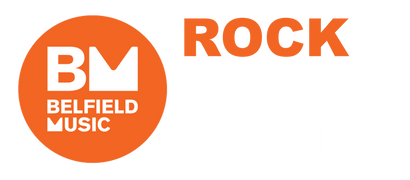Your Cart is Empty
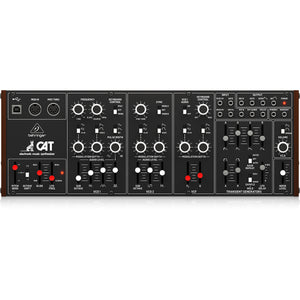
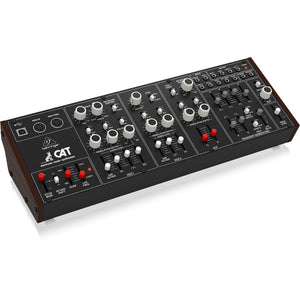
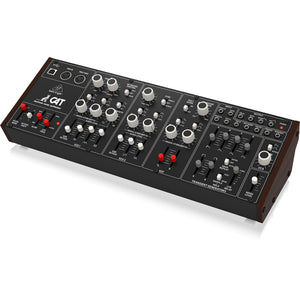
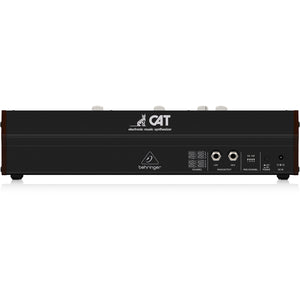
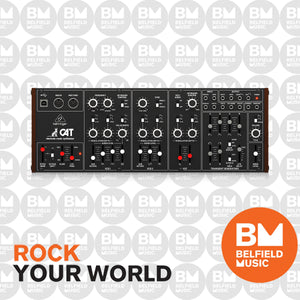
Product Information
CAT
The 1970s spawned the first truly portable analog synthesizer, and while it was quickly adopted by lots of renowned musical artists including Jan Hammer, Chick Corea, Rick Wakeman, Jean-Michel Jarre, Isao Tomita and Keith Emerson to name a few, it was somewhat temperamental and very expensive.
In 1975, a new synth strolled into town. The Cat as it was called was an analog, duophonic, three octave synthesizer that was very similar to the ARP Odyssey. Its keyboard would produce two control voltages that were routed into its two VCOs. An ultra-affordable and even more feature-packed homage to that iconic synthesizer comes in the form of the Behringer CAT. Conjure up the virtually any sound imaginable with incredible finesse and ease. The pure analog signal path is based on authentic VCO, VCF and VCA designs in conjunction with 4 variable and simultaneous oscillator shapes and Duophonic/Paraphonic capabilities. Owning a CAT is like having your own personal time machine, enabling you to freely embrace the past – or shape the future. And the best of all, it doesn’t scratch.
True to the Original
Great care has been taken in engineering the CAT, including the true to the original analog circuitry, legendary VCO, VCF and VCA designs that come together to recreate classic tones that are evocative of classic electronic music. This highly-focused attention to detail is what gives the CAT its ultra-flexible sound shaping capability. It gives you the ability to cover a lot of amazing tones from super-fat bass, tasty leads – and all the way to full on dreamy ambience from the far reaches of your imagination.
Big, Fat Tones
The synthesizer tracks laid down in the 1970s and 80s in progressive rock, wave and synth-pop have become classics and have inspired many other artists. The CAT lets you recreate all that magic – or design some incredible and original sounds that will make you a legend in your own right!
Keyboard Control
The CAT has the ability to accept any keyboard controller via MIDI. The signals generated can be tweaked via the Pitch Bend slider which can bend a note up or down one octave. Bump this up to two octaves by flipping the Octave Shift switch up or down. Use the Glide slider to change how fast a note transitions to another; up is faster, down is slower. Combine that with the LFO Freq slider to control the LFO and ADSR repeat tempo and you can create some amazing pulsating portamentos.
Two VCOs are Better
The very heart of the CAT’s sound is its two VCOs. The Duophonic/Paraphonic nature of the CAT allows both oscillators to be controlled independently. Use the Fine and Coarse Frequency controls to tune VCO1 to VCO2. Keyboard control on the CAT can be set to either Mono or Poly. Poly mode lets VCO1 generate the highest note played on the keyboard while VCO2 handles the lowest allowing two notes to be played simultaneously. Setting the switch to Mono mode makes VCO1 generate the lowest note depressed on the keyboard.
Make Waves
Waveform switches on both VCOs allow different waveforms to be patched in from the LFO. Choose between Sine, Square, Sample and Hold and even pitch modulation through each VCO. Turning the Modulation Depth knobs in either direction controls the intensity of the effect. VCO2 also comes with a Sync switch that locks VCO1 with it and has them act as one huge oscillator to produce more complex waveforms and dramatic results. Mix VCO1 into VCO2 or vice versa and the CAT can produce some really tasty tones that make themselves at home in your next synth jam.
Slide In
Each VCO on the CAT comes equipped with their own waveform sliders where you can adjust the volume of each type of VCO wave form. Pump up the Sub Octave, Sawtooth, Square, Triangle or Pulse waves or mix them all together and create some truly unique tones.
VCF
As if combining two VCOs wasn’t amazing enough, the CAT comes with another set of claws in the form of a VCF filter section. Here you can get more complex and robust tones by incorporating VCO1 into the mix. Introduce more waveforms and manipulate the Q slider to emphasize harmonics and Filter Cutoff slider which acts as a low-pass filter. Turn the CAT into a really funky bass machine or an out-of-this-world synth that creates some searing lead tones. You can even create some amazing drum sounds by manipulating the VCOs, VCF and ADSR.
The Envelope, Please…
To give the signal even more character, you can use the CAT’s Transient Generator to create a detailed voltage transient every time a key is depressed. Adjust the Attack, Decay, Sustain and Release via the matching sliders and to shape your signal. The AR transient generator works similarly to the ADSR but with less detailed control over the envelope. You can also set the ADSR to automatically repeat or only when a key is held down. The Sample and Hold switch can be set so the VCO1 setting is sampled or, when set to Noise mode, produce a random output pattern. Slide the LFO Delay control up or down to determine when the LFO will reach its maximum output after a key is depressed.
The Ins and Outs
The CAT features a whole slew of Inputs and Outputs that expand its capabilities beyond what you can see out of the box. You can route external control voltages to VCO1 or 2, the VCF and even pump in some external line-level audio into the CAT. You can even connect the CAT to other external synthesizers through the Gate, ADSR, AR or Keyboard Outputs. The CAT’s 16-note Poly Chain function lets you combine multiple synthesizers for up to 16-voice polyphony – and it provides vastly improved reliability and stability over its 1970s and '80s predecessors.
Controls & Connectivity
We just can’t help ourselves – like you, we're gear-heads, too. For those who want the numbers, the CAT has 47 controls, all laid out in a highly-intuitive format that puts the joy back into your music creation.
Unleash Your Imagination
When it comes to not just pushing envelopes but creating them, the CAT gives your imagination its voice – and it’s so very affordable. When modern performance calls for classic analog sound – it calls for the Behringer CAT!
Visit your dealer to experience the stunning CAT or get yours online today. Music never felt this good!
A Brief History of Analog Synthesis
The modern synthesizer’s evolution began in 1919, when a Russian physicist named Lev Termen (also known as Léon Theremin) invented one of the first electronic musical instruments – the Theremin. It was a simple oscillator that was played by moving the performer’s hand in the vicinity of the instrument’s antenna. An outstanding example of the Theremin’s use can be heard on the Beach Boys iconic smash hit “Good Vibrations”.
Ondioline
In the late 1930s, French musician Georges Jenny invented what he called the Ondioline, a monophonic electronic keyboard capable of generating a wide range of sounds. The keyboard even allowed the player to produce natural-sounding vibrato by depressing a key and using side-to-side finger movements. You can hear the Ondioline on Del Shannon’s “Runaway”.
Storytone Piano
Designed by famous piano manufacturer Story & Clark in association with RCA, the Storytone piano debuted at the 1939 New York World’s Fair. Hailed as the world’s first electric piano, the Storytone is prized by musicians and collectors alike for its realistic piano sound – only 500 or so were ever built.
Mellotron
Finding a high level of acceptance in the 1960s, Harry Chamberlin’s Mellotron was an electro-mechanical keyboard that generated sounds by playing back pre-recorded tape loops. Although tempermental and prone to pitch and mechanical issues, the Mellotron was used extensively by many U.K. artists. Classic tracks from the Moody Blues “Days of Future Passed”, the Beatles “Strawberry Fields Forever”, and the Rolling Stones “She’s a Rainbow” are prime examples. Attribute author: By Buzz Andersen from San Francisco, California, United States Mellotron | NAMM 2007
Arp 2600
Manufactured by ARP Instruments, Inc., the Arp 2600 was one of the most successful synthesizers to come out of the 1970s. They were ideal for players new to the synth world, and allowed patches to be changed via switches or 1/8" audio cables. The list of recordings and artists that used the venerable Arp 2600 reads like a veritable Who's Who of rock, pop and jazz, and includes The Who, David Bowie, John Lennon, Depeche Mode, Edgar Winter, Frank Zappa and Herbie Hancock – to name just a few. An Arp 2600 was even used to create the voice of the Star Wars character R2-D2. Attribute author: The original uploader was Kimi95 at Italian Wikipedia -
Minimoog
Designed to replace the large, modular synths being used in pop music at the time, Bill Hemsath and Robert Moog developed the Minimoog in 1971. The monophonic instrument became the first truly all-in-one, portable analog synthesizer. Thanks to its 3 oscillators and 24 dB/octave filter, the Minimoog produces an extremely rich and powerful bass sound and is still in high demand today. Yes keyboardist Rick Wakeman said the instrument “absolutely changed the face of music.” Attribute author: glacial23 - Early Minimoog Uploaded by clusternote, CC BY-SA 2.0
Yamaha CS-80
In 1976, Yamaha released their CS-80 8-voice polyphonic synthesizer, which provided velocity-sensitive keys and aftertouch that worked on individual voices. The analog instrument featured a ribbon controller, which allowed the user to perform polyphonic pitch bends and smooth glissandos. Composer Vangelis used the CS-80 extensively in the Blade Runner and Chariots of Fire soundtracks. The CS-80 also provided the bass line heard in the BBC 1980 series Doctor Who theme song. Image attribution: Pete Brown from Gambrills, MD, USA (DSC00539) [CC BY 2.0 (http://creativecommons.org/licenses/by/2.0)], via Wikimedia Commons
Sequential Circuits Prophet 5
Sequential Circuits introduced the Prophet 5, which was the first analog 5-voice polyphonic synthesizers to provide onboard memory storage of all patch settings for instant recall. The great-sounding Prophet 5 revolutionized the synthesizer world and, in spite of its rather expensive price tag, became one of the most successful synths of all time. Designed by Dave Smith and J owen, the Prophet 5 was the keyboard of choice by a very long list of performers that includes Peter Gabriel, Philip Glass, Journey, The Cars, Thomas Dolby, Duran Duran, Gary Numan, Pink Floyd, and countless others. Image attribution: original uploader was Felix2036 at Dutch Wikipedia derivative work: Clusternote (Sequential_Circuits_Prophet_5.jpg) [Public domain], via Wikimedia Commons Which brings us to 1977...
A Passion for Keyboards
Our founder, Uli Behringer has a deep passion for keyboards. Born in the small town of Baden, Switzerland in 1961, Uli grew up in a musical family where his mother taught him to play the piano at the tender age of four. His father was a scientist who built a massive organ in the family home and taught the young lad all about electronics. So at the age of 17, Behringer built his first synthesizer – the UB-1. Later, while attending college to seek a degree in audio engineering, Uli put his electronics knowledge to use, building his own equalizers and signal processors to fill the gap left by the university's inability to provide enough proper studio gear. Word soon spread about how good his products were, and he began building gear for his friends – the Behringer legacy had begun. The rest, as they say, is history...
Specifications
-
Amazing analog synthesizer with dual VCO design allows for insanely fat music creation
-
Authentic reproduction of original "CAT SRM II" circuitry with matched transistors and JFETs
-
Pure analog signal path based on authentic VCO, VCF and VCA designs
-
4 variable and simultaneous oscillator shapes (Sawtooth, Triangle, modulated Pulse and Sub-Octave Square) for ultimate sounds
-
Duophonic/Paraphonic mode allows both oscillators to be independently controlled
-
Oscillators can be modulated from 6 different sources with 2 modulation depth attenuators
-
Classic filter design (low pass with peak/resonance) with self-resonance capability
-
Filter can be modulated from 6 different sources with 2 modulation depth attenuators
-
Dedicated and fully analog sine/square wave LFO
-
2 analog Envelope Generators for modulation of VCF and VCA
-
White noise generator dramatically expands waveform generation
-
16-voice Poly Chain allows combining multiple synthesizers for up to 16 voice polyphony
-
Complete Eurorack solution main module can be transferred to a standard Eurorack case
-
47 controls give you direct and real-time access to all important parameters
-
Audio input for processing external sound sources for enhanced creativity
-
External control inputs and outputs (High Note CV, Low Note CV, Gate, Filter etc.)
-
Comprehensive USB/MIDI implementation with MIDI channel and Voice Priority selection
Warranty
3 Years WarrantyShipping & Delivery
All orders over $100 will be automatically eligible for FREE Shipping Australia Wide, if you order is under $100 there will be a flat rate of $10.
Belfield Music is well known for its top online customer service. We treat all online customers with the same excellent service we give to our in store customer. We will ensure that you receive all the support you need while your goods are in transit and ensure the goods arrive promptly. All of our shipments have tracking numbers available and we cover every single unit by our own shipping insurance.
Online orders are normally processed within 1-3 business days. Once processed, your order should take between 1-8 business days to arrive depending on your location. Please note that your order may take up to 10 business days to arrive from the day you place your order.
If it transpires that the product is out of stock due to a stock discrepancy and/or there will be a delay in shipment, we will contact you within 2 business days of placing your order and give you the option of waiting or cancelling your order. The products we advertise online should show if they are in stock or not. We do our best to keep the website stock count up to date, but there may be an occasional error.
If you wish to utilize an Express Delivery Service to receive your item, please contact us for a shipping quote before you place your order at admin@belfieldmusic.com.au or by using the Chat icon on the bottom right of the page.
Deliver is made during the hours from 8:00am till 5:30pm Monday to Friday. As such, please ensure you nominate an address which is capable of receiving goods during 8am and 5.30pm. Given the restrictions on PO Box deliveries we cannot deliver larger sized items to a PO Box.
If for any reason our selected carriers don't service your area we will contact you before processing your order if this applys to you.
Returns Policy
If you wish to return an item which is not damaged or faulty in any way and you have simply changed your mind or made the wrong decision, you must let us know within 7 days of receiving the item. We will not agree to refund an item because you simply changed your mind or made the wrong decision if we have not been advised of your intention within 7 days of receiving your item. Once we have provided a return authority, it is the buyer’s responsibility to return the item, at their own costs within 30 days from original purchase. If the item is returned with any damage or alteration to its original packaging, we will refund the item subject to applying a minimum 15% restocking fee. We will not refund the costs of the initial shipping charges.
It is in Belfield Music best interests to keep our customers happy with their purchases. If you are not happy with your purchase, please talk to us first. We will always attempt to resolve any problems you may have as best we can. To contact us please email us at admin@belfieldmusic.com.au or by using the Chat icon on the bottom right of the page.
